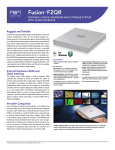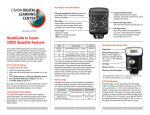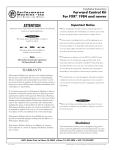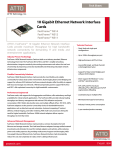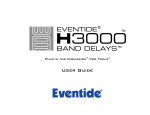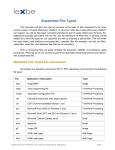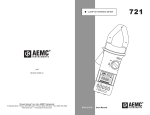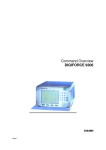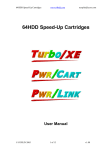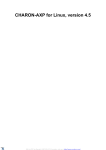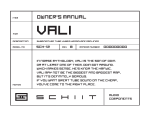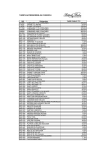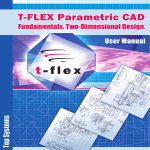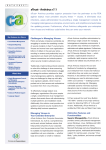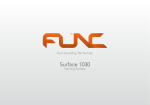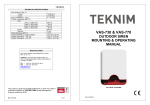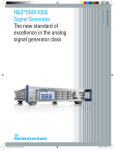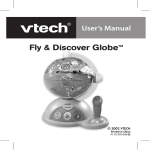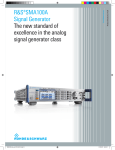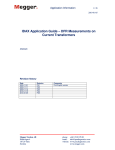Download Exclusively distributed by Cinemaware Corporation 4165 Thousand
Transcript
Only Warpspeed loads, saves, verifies, formats and copies files at speeds up to iOx faster than normal! Imagine copying a disk in as little as 35 seconds! Warpspeed functions identically on both the C64 and C128 in the 40 or 80 column mode and works with all compatible drives, including the 1581. Built in mode select and reset switches too! Attention advanced users: An integrated sector editor and drive monitor and a full featured mini-assembler are all included! Only Warpspeed delivers 55 features that no other cartridge can match. Why limp along on impulse power when you can jump to Warpspeed? Exclusively distributed by Cinemaware Corporation 4165 Thousand Oaks Blvd., Westlake Village, Ca 91362 C64. C128 and 15B1 drive are trademarks o( Commodore Electronics. Ltd. Warpspeed i5 a trademark ol Allen Technology Group. HARDWARE REVIEWS Warp Speed Computer Commodore 64 and 128 Publisher: Cinemaware Corporation 41654 Thousand Oaks Blvd. Westlake Village, CA 91362 Medium: Cartridge Price: $49.95 Warp Speed is not only the catchy ti tle of this fast-load utility cartridge, but also the best description ofjust how fast this cartridge will become successful. Commodore 64 and 128 users will prob ably leave this cartridge in the expansion port permanently, because of the capabili ties that include a fast-loader, a DOS wedge, a sector-editor, a machine lan guage monitor, assembler, file utilities, and drive renumbering. Even more amaz ing is one application for a 641571 disk drive system that will put a Cheshire cat smile on user's faces. Fast Loading Before we get to the "Gee whizzery," it's probably safe to say that Warp Speed functions work identically on the 64 and 128 in both 40- and 80-column modes (128 only). Compatibility with disk drives is another plus. In addition to working with the 1541 and 1571 drives, the cartridge works with the new Commodore 1581 floppy drive, the new hard disk drives (from various manufacturers!, and the MSD dual drive. Use of the cartridge with any system configuration is straightforward. Once the computer is initially powered up in BA SIC, the simple cartridge commands allow rapid loading of commercial or user-writ ten programs. The routines will work with any application which uses Kernal load and save routines, but not the Kemal re store routine—which resets the vectors to their default values. The cartridge is fully compatible with most commercial software. Commercial software with ''normal" copy protection will load about four times faster. And Warp Speed also works with many heavily protected programs that are usually in compatible with other cartridge utilities. However, some of these heavily protected programs (less than 1%) have special car tridge detect codes that prevent the fastload capability. Fast loading of commercial software, and even home-grown software, is also af44 SEPTEMBER 1988 fected by the disk drive. For example, the 1571 drive saves information in a format that is able to read data faster than a 1541, allowing the Wurp Speed cartridge to load the software ten times faster than normal. Warp Speed also allows the 64 to use the 1581 drive. Expanded DOS Wedge In addition to the fast load capabilities, there is a full complement of DOS com mands—including accessing of the drive command channel, saving and verifying files. All uf these functions are possible with easy notation, rather than the BA SIC commands. Easy notation is also available for many new commands that are built into the cartridge. One such command is Type File, which enables the listing of any nor mal text file to the screen. A simple am persand i&) followed by the filename will load the text file on the screen. There is even a Print Screen feature, which can be combined with Type File to print such items as the "README.DOC" files that come with many public domain programs. Still another new command—the Menu-formatted Directory—allows the user to display the directory in a menu format, enabling programs or files to be automatically loaded with the cursor and RETURN keys. There is even the abili ty—when in BASIC—to turn the car tridge fast-access routines "on" or "off." Software contra! of the disk drive number is also possible. Impressive Storage If you're impressed with the software control of the disk drive number, you'll be amazed with this next application. Com modore 64 users who have 1571 disk drives will buy this cartridge just for the ability to access a whopping 1328 blocks of disk space without flipping over their disks. Once the disk is double-sided for matted, files are stored and retrieved without any disk removal from the drive. In other words, it is just like having a sin gle 1541 disk, but with twice the storage space—1328 blocks of storage. Setting up this 1328-block storage is easily accomplished while still in BASIC by first commanding the 64/1571 system to use the 1571 in a double-sided mode. In this mode both sides of the disk are for matted without removing the disk from the drive. Only one BAM is used for both sides of the disk. In testing out this technique it seemed best to toggle back into the single-sided mode while "loading" files from other sin gle-sided disks. Next, it is best to re-toggle back into the double-sided mode for "sav ing" the files on the double-sided format ted disk. The ''arrow-up" key and either "D" or "S" combines for the toggling be tween the double-sided or single-sided disk use. The double-sided mode also improves the speed of scratching and validating files. However, when loading most copy protected software, the double-sided mode should not be used. In all cases when mov ing in and out of the double-sided and sin gle-sided mode, care must be taken to en sure that the correct sides are formatted. Utilities Abound Moving out of BASIC and into either the sector editor, the machine language monitor, the file utility or the copying pro gram is easily accomplished with the typ ing of a pound sign i#) to activate the menu. Returning to the main menu from any of the sub-menus is as easy as press ing "Q." The sector editor is for editing data or program files directly on disk. Any sector Hardware Reviews/Warp Speed on any track can be edited—either by changing the hexidecimal code, or by making actual changes to the text in that sector. The new sector can then be written back out to disk. Working in the sector editor is extreme ly easy. Both the hexidecimal and text version of the sector are shown on the screen. A simple plus ( +) or minus (-) displays the next higher or lower sector. The SHIFT key—in combination with the plus or minus sign—moves up or down one track. Printing the entire sector (both hexidecimal and text! is completed by pressing "P." Commercial software with "normal" copy protection will load about four times faster. Saving the new edited version of the sector to the same disk drive, or a second target drive, is again done with one key stroke. Both the source and target drive numbers are shown on the screen. And these drive numbers can be changed in any combination. One keystroke also moves the program between the sector editor and the machine language monitor. Sectors can be copied from one disk to an other. Warp Speed's machine language moni tor is probably one of the most advanced ever produced, yet it uses the syntax of most previous monitors. All the usual sec tions are available—the program counter, status register, the three data registers and the stack pointer. Also, there is an IRQ indication that tells to what address the computer will go if an interrupt oc curs. Within the machine language monitor, files can be completely disassembled by indicating starting and stopping address. Areas of memory can be compared, indi cating the addresses at which the memory locations are different. Blocks of memory can be filled in with constant values. Also, there is a hunt command that gives all the addresses having specifically soughtafter contents. The monitor has the ability to transfer blocks of code from one memory location to another. And blocks of memory can be transferred to and from disk drive mem ory. As in the screen editor, all screen infonnation can be dumped to a printer. Programs are easily assembled, loaded. saved or verified, all while in the machine language monitor. Next on the menu is a file utilities sec tion, which allows files to be copied or scratched. Within this feature source and target drives can be set, programs can be auto-loaded using the disk directory automenu feature, and drive commands can be used. Finally, disks can be copied, using ei ther one or two separate drives, or a twodrive unit (dual copier mode). The single copier routine also verifies both the source and target disks for bad sectors. And, the single copier compresses the data during the read process, permitting the copying of the complete disk in fewer passes. If a 1571 drive is used, double-sided disks can be copied. There are some other commendable at tributes of this cartridge. First, the car tridge is the size of a normal game car tridge. For convenience, there is a reset button, and a 64128 mode switch placed on the cartridge face. Secondly, the cost has been kept minimal because of clever programming. Cinemaware acknowl edged that all of the capabilities of the cartridge started out as 32K of machine language code. However, this program was rewritten over and over to fit into the Hardware Reviews/Quick Brown Box— Continued from page 43 With the plethora of cartridge capabilities, there would be confusion except for the excellent, detailed and accurate manual. comes in handy if you write a program and want to know whether or not it can be saved to a particular disk. You can easily jump from viewing the disk directory with the number of blocks available, to viewing the cartridge directory with its listing of the number of blocks needed. However, there is a minor drawback that probably will never be noticed by most users. This is that the 64 and 128 program cannot be loaded into the box at the same time- Both types of programs have different Manager software. Great Documentation With the plethora of cartridge capabili ties, there would be confusion except for the excellent, detailed and accurate man ual. For computerists who have some un derstanding or interest in more than just 16K ROM chip in the game-size cartridge. What is not commendable, however, is that it seems the publishers also com pressed the user's manual to half the size it .should be. In this case, what results is a manual that is not clearly written. Be cause of the difficulty in the manual orga nization and explanation, users will find a greater-than-usual amount of trial-anderror necessary to work through some of the command structures. Some problems result from this manual deficiency. Kor example, there is nothing in the manual that indicates how to for mat a single-or double-sided disk. Correct command structures are misleadingsome require the use of quotation marks, some don't. The copy command automati cally formats the disk, but does not format double-sided disks, even if you toggle "Double" in the sub-menu. In the File Utilities, it is unclear exactly how to copy the file. With a little effort, Cinemaware could reorganize and revise the entire manual. They should add step-by-step examples and be more exact in the listing of the command .summaries. With this second manual revision, Warp Speed will race for ward like the Rolls Royce engine that it is, and even look a little classier. 3 games, the manual provides fundamental information about the technical aspects of the QBB use. This fundamental information provides the understanding to the coding or pro gramming use of the QBB. Details of memory location positions and what is happening with the registers are all given with clear description. The style of writing gives the fundamental operation first, the procedure second. Understanding the pro cedure is based on understanding the fun damental operation. Chapters are organized clearly and topically. Even cross references are made to other paragraphs where needed to clari fy information. However, a "first things first" section is needed. Brown Boxes, Inc. has realized this and provided it as an ex tra letter to the user. This letter should be come the first page of future revisions of the manual. Cartridge expander cards, utility car tridges and other cartridge RAM systems are becoming more prevalent in the 64/128 world. This 64K RAM cartridge is certainly at the top of the list, both in its technology and in its productivity capabil ity. The next question might be, "What about a 128K version for an encore?" a COMMODORE MAGAZINE 45



